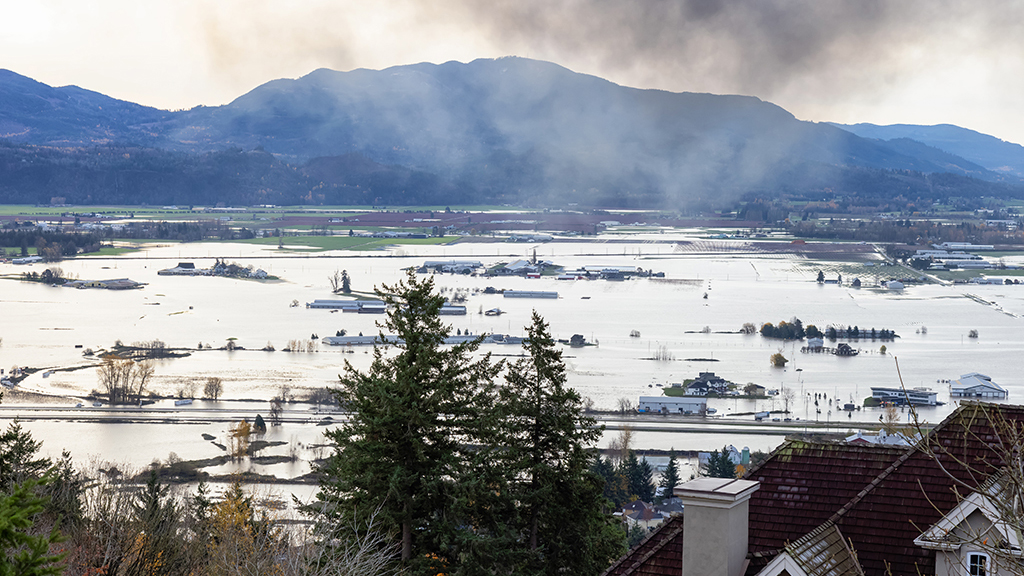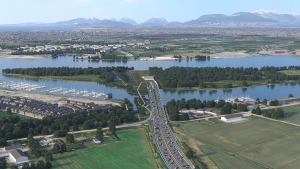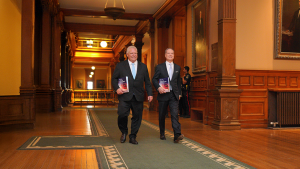Abbotsford’s dikes are in a better position than last year when atmospheric rivers deluged the Lower Mainland-U.S. border area, flooding Abbotsford’s Sumas Prairie, said Mayor Henry Braun, but the area is still highly vulnerable.
It needs both a short-term fix and long-term $800 million pumping station to be built as soon as possible.
The city wants to see the proposed pumping station uncoupled from its $2.8 billion approved multi-phase flood mitigation plan that will enable more water to be pumped away from valued agricultural land that was flooded when the U.S. based Nooksack River overflowed.
The new Sumas River Pump Station would improve the resilience of the Barrowtown Pump Station which laboured under the flooding last year.
The city was unable to open its flood gates draining water into the Fraser River as the level was too high and would have caused a back-flow.
“The flood gates are the weak link in the system,” Braun said.
The hold-up is provincial and federal funding, yet to be handed over to the municipality to do the needed work as the municipality heads deeper into fall and winter.
“We had nine breaches (in the dikes last fall) in total but the media focused mainly only the big one which was 100 metres wide. We have all the breaches repaired including the biggest – but that one is on a temporary basis,” he said, as the large boulders in place are still allowing some water to seep through. Braun said provincial funding for the permanent repair is “imminent” and the city is awaiting the funds. The work is expected to take three to four weeks and he said the city’s engineering department has already started determining which contractors would be qualified to do the work.
“The work has got to be done before November,” Braun said, anticipating it should start in October in a bid to stop-gap the impact of any atmospheric rivers heading towards the area.
He said B.C. experiences 20 to 25 of these events on the West Coast.
Last year the city experienced not one but three of these systems deluging the Fraser Valley.
Abbotsford will strengthen its position with the permanent repair on the short-term against these severe systems as it has already raised the level of its dikes by half a metre.
But, the area remains vulnerable.
“We can handle two of these – maybe three – but it will be touch and go,” Braun said.
“We are hoping the province and federal government will sign off the pump station.”
He has had discussions with federal Public Safety Minister Bill Blair who told him the federal government would be willing to support the funding of the decoupled pumping station proposal but not before the B.C. government has approved the construction.
“The ball is clearly in the province’s court,” he said.
The transfer of funds would only begin a long process of evaluating sites, geotechnical work, plus the design work, ordering components and construction. Braun said the whole process could take up to five years.
“I keep telling people, we have a ways to go yet,” he said, adding he is hopeful by the time construction begins supply chain difficulties will be resolved.
Braun, who steps down as mayor this fall, said he expects geotechnical and design work for the new station and a canal to divert water could begin in 18 months if government approval is given.
He does not believe a change in council or mayor will change the plan as it has extensive public vetting.
The endgame is implementing the total flood mitigation plan, which is a hybrid drawing components from three of four options outlined to council and will bring dikes up to provincial standards and protect some of the Lower Mainland’s most valuable agricultural land.
Part of that $2.8 billion mitigation plan included revamping its drinking water system which has been impacted during flooding.
In mid-September, the B.C government announced it would supply $62 million for the $84 million upgrade, with the remainder coming from the Abbotsford Mission Water Sewage Commission.
Despite waiting for the province to affirm the plan for new Sumas pump station, Braun is not unhappy with the province.
“I am pleased with the response and the direction we are going,” he said.
The flooding is estimated to cost $1 billion in losses to the Abbotsford agricultural industry. It is also being addressed by a U.S. and B.C. contingency, although a year after the disaster little mitigation progress has been made. According to an email sent by B.C., talks have been carried out.
“Together, we are working on establishing a governance structure to advance the identified priorities under the trans-boundary initiative. As part of this initiative, a small delegation led by the premier’s liaison to Washington State, MLA (Rick) Glumac, undertook a technical site visit to the Nooksack River on July 21, and a second technical site visit in B.C. is scheduled in late September that will be co-hosted by the City of Abbotsford and the Sumas First Nation. Any future investments regarding dike infrastructure will need to take into consideration what projects occur south of the border,” an email from Krystal Thomson, communications director of Emergency Management BC, explained.











Recent Comments
comments for this post are closed